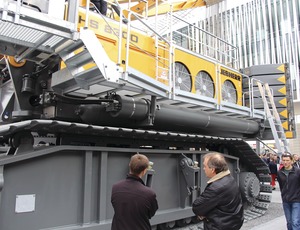
As fuel prices keep climbing, the business case becomes stronger for hybrid power on heavy equipment. But the payoff period for heavy-duty hybrids is still fuzzy, and equipment designers face the tough decision of which technology to pick.
Excavators consume a large amount of fuel when swinging back and forth between digging and dumping. This swinging motion alone gobbles up to 70% of the energy needed to operate an excavator, according to Ken Gray, global product manager for Caterpillar Inc.
"If you are going to pick a circuit to start with [for hybrid power], it's the swing," Gray told ENR this April at the Bauma 2013 expo in Munich, where Cat displayed its new 336EH hybrid excavator. "It's the biggest bang for your buck."
Some hybrid excavators have followed a similar path as have hybrid cars: An internal-combustion engine drives one or more electric motors; during braking, the motor reverses to serve as a generator. Some hybrids also use batteries or capacitors to store energy. These electric systems take a load off the engine, reducing fuel consumption and emissions. Komatsu built the first excavator of this kind in 2008 and has since sold more than 2,000 units worldwide.
On heavy equipment, these electrical components are still expensive. Just the capacitors cost $40,000, some experts estimate. Add up the other components and the premium on the machine can rise well above 20%. In its research, Cat found that the payoff of a diesel-electric hybrid excavator was around seven years. Engineers are now harnessing a technology found on most machines—hydraulics—at a fraction of the cost of an electric drive.
Cat's 40-ton 336EH hybrid excavator costs $410,000, or 9% more than the non-hybrid version, and improves fuel efficiency by 25%. The manufacturer estimates a payback in one to two years. When the machine enters its second life, replacing the hydraulic components costs a fifth that of hybrid electric parts. "It's really simple technology," Gray said. "That's why this works."
Reversing Flow
Initially, Cat built two versions of the 336EH: an electric hybrid, which Gray said was on the prime path, and a hydraulic hybrid, which was more of a Skunk Works experiment. The Peoria, Ill.-based company held focus groups three years ago, and the feedback was loud and clear: Electric-hybrid excavators take too long to pay back, require extra training time and come with high replacement costs.
Users also felt more comfortable with the hydraulic system. "The most important thing is that we don't change the way the customers use the machine," Gray explained, adding that hydraulic-hybrid power will be coming to more Cat machines. "I think it translates very well up and down the product line," he noted.









Post a comment to this article
Report Abusive Comment